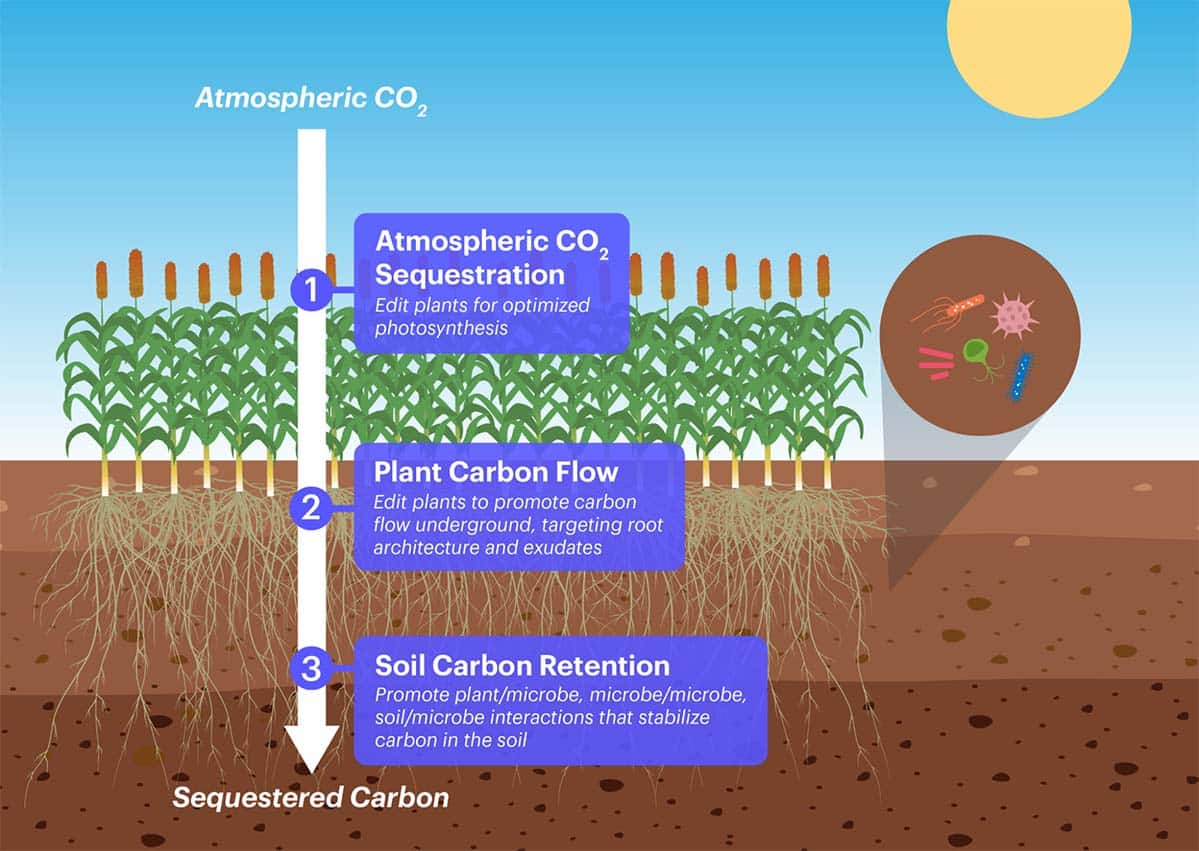An $11 million grant from Facebook founder Mark Zuckerberg and his wife Priscilla Chan’s foundation (CZI), is exploring using CRISPR gene-editing to remove carbon.
The recipient, the Innovative Genomics Institute (IGI), is looking to enhance the ability of plants and soil microbes to capture and store carbon dioxide.
As per the Intergovernmental Panel on Climate Change (IPCC), Carbon Dioxide Removal (CDR) has an important role in mitigating the impact of climate change. And that’s on top of measures in reducing actual carbon emissions.
When it comes to removing carbon from the atmosphere, the planet has old technologies to do that very well. Plants, microbes, and other organisms have been doing it already. But they’re naturally designed to do the work without the big amounts of too much CO2 from humans.
And so, the IGI project aims to fill this gap by enhancing the natural carbon removal abilities of living organisms. This is important in meeting the scale of the global warming crisis.
Soil Carbon Removal And Storage
One of the key challenges with nature-based CO2 removal solutions is that they tend to draw and store carbon for a short period of time. Soil microbes often respire CO2 not long enough after it has been captured.
In effect, some people are doubting the ability of natural solutions like soil carbon removal to offer significant impact. After all, carbon has to stay in soils for decades for them to aid in abating climate change.
Around two centuries ago, soils were reliable and long-term carbon sinks. Also, plants and microbes not only have the ability to capture CO2 from the atmosphere. They can also store it in biomass and in soils of croplands covering ⅓ of the Earth’s land surface.
In a sense, focusing on globally important commercial crops like rice ensures that the impacts of adopting this CDR spreads around the world and benefits communities.
But that was until modern agriculture was born and altered things.
For instance, disrupting the soil structure like converting forests and grasslands to farmland, speeds up the process of releasing the captured carbon. When this happens, the planet heats up more.
- Since then, soils have released about 487 billion metric tons of CO2. That’s a huge amount, representing the U.S.’s cumulative fossil CO2 emissions since the industrial revolution.
This is where the IGI team enters by grabbing the chance to boost the levels of soil carbon in agricultural lands. Doing so will not only benefit soil structure and reduce emissions. It can also improve water use efficiency and nutrient availability, and feed the good microbes.
Aside from enhancing soil carbon removal ability, the research team expects other benefits, too. These include higher yields and reduced amounts of fertilizers and irrigation. All these can help the whole population.
Plus, farmers or ranchers can also have another revenue stream by earning soil carbon credits. They’re credits that correspond to certain amounts of verified carbon captured and stored in the soils.
CZI’s Investment in IGI’s CRISPR Tech
CZI has been investing in innovative technologies to help fight climate change. CDR technologies are one of them and the IGI program is one of its supported initiatives.
The IGI team is one of the first to use CRISPR genome editing in the field of CDR.
CRISPR is a powerful tool for editing genomes that allows researchers to alter DNA sequences and change gene function. It offers a lot of potential applications.
These include correcting genetic defects, treating and preventing the spread of diseases, and improving the growth of crops.
This technology was adapted from the natural defense mechanisms of bacteria and other microorganisms. With this new study, the IGI team thinks that it becomes possible to enhance plants and soil microbe’s carbon capture.
That could be a net increase of 1.4 billion metric tons of CO2e drawn in each year. Half of that can be kept in the long-term if combined with biomass conversion technologies.
Dr. Chan, CZI’s co-CEO and co-founder said that:
“We’re excited to support the Innovative Genomics Institute’s important research into new applications of gene-editing technology… This has the potential to supercharge the natural abilities of plants, enabling them to pull more carbon out of the atmosphere and store more carbon in their roots and the surrounding soil…”
Chan believes that it will provide a new set of innovative tools to address climate change.
As for CRISPR’s application to soil carbon removal, it’s equally a thrilling step on how it was also used in agriculture.
The IGI Program in 3 Groups
As shown in the image below, the IGI’s soil carbon removal program includes three groups. They’re composed of researchers at UC Berkeley, UC Davis and Lawrence Livermore National Laboratory. Each focuses on a different stage of the CO2 journey from the air through plants to roots and into the soil.
1st group: focus on editing rice varieties for improved photosynthesis to remove CO2 from the air. Optimize root development to boost soil CO2 sequestration.
2nd group: develop new genome editing protocols for the biomass crop sorghum to allow editing for enhanced CDR.
3rd group: create techniques to trace CO2 fixed by improved cultivars. Study soil microbial communities that promote long-term CO2 storage.
The success of this initiative in impacting the real-world scenario calls for widespread adoption. And so, another group will ensure that the progress of the teams’ work meets the users needs.
Though efforts were started in local fields, this soil carbon removal is meant to scale up rapidly around the world.
The IGI team’s work is scalable as it also applies to other crops, such as wheat and corn.


